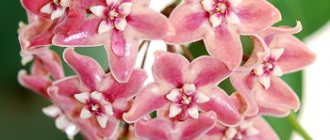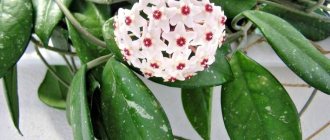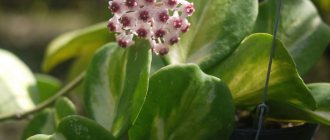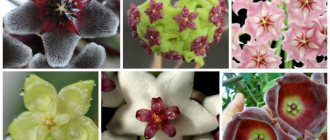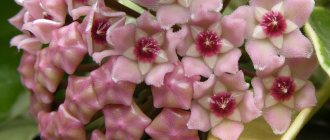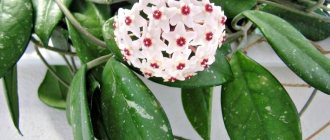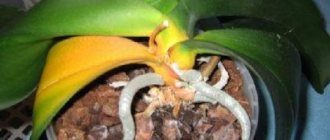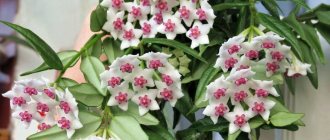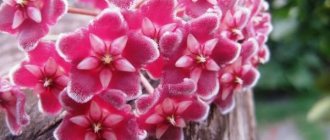Plants » Flowers
0
268
Article rating
Kira Stoletova
Hoya Australi Lizas, or Southern, was found by scientists Solender and Banks on the Australian coast. Later this species was discovered on the islands of Fiji and Samoa, in South Asia. The plant is very popular in home cultivation due to its decorative flowering, unpretentiousness and easy care.
Hoya australis lisa
Features of care and reproduction
Lighting
The plant prefers diffused sunlight, so you should not expose Hoya to the sunny side of the window. But if the windows in your house do not face the south-east and/or south-west, then you need to protect the flower as much as possible from sunburn on the south window.
Room temperature
The optimal temperature for good plant growth is from plus eighteen to twenty-five degrees in the summer and from plus fifteen to seventeen degrees in the winter.
Read also Harvesting beans for the winter at home
Rest period
The vine does not have a main, pronounced period of rest, but if you consider that in winter the air temperature is slightly lower than in summer, you might think that at this time the plant will have time to rest in order to gain more strength before rapid growth and flowering in the summer. .
Humidity
Fortunately, for many gardeners, the vine does not need high humidity. But this does not mean that it will not respond with lush flowering to a warm shower. If we are talking about spraying from a spray bottle, then this should be done only if the air temperature heats up above twenty-five degrees or during abnormal heat or drought that lasts for a long time. This will help prevent a decline in leaf turgor and keep the plant in good shape.
Watering
Watering should be such that the roots have time to absorb water from the previous watering, but do not dry out. If there is water left in the tray when watering, then you should wait about half an hour until the plant absorbs additional water, and everything that remains needs to be poured out to prevent rotting of the root system. Hoya, like many other plants, needs to be watered with settled water, which is heated to room temperature. Under no circumstances should you water your hoya with cold water during the daytime in summer. Cold water will have a bad effect on soil steamed from sunlight!
Transfer
The plant should be replanted when the roots of the flower are visible or come out through holes to drain excess water. Replanting can be done either by transferring from one pot to another, or by washing the roots from the old soil and replanting them into a new substrate.
Reproduction
Reproduction can occur either by layering from an adult plant or by cuttings.
- In the first case, one of the branches of the vine is planted in another pot or placed on the surface of the ground with moss to provide more moisture. You can also install a small greenhouse.
And then they wait for the vine to give new roots and shoots. The mother branch can then be cut off. In the second case, the vine is cut into small cuttings and planted in pots.
It is also recommended to install a greenhouse here. It must be remembered that the greenhouse must be ventilated from time to time to prevent plant rotting.
Under no circumstances should you over-wet the soil. For better results, before planting the cutting, you can dip it in Kornevin.
The cuttings can be planted directly into the ground, or you can put them in water and wait until good roots appear and only then plant them in the ground. Both methods will be correct if all conditions are met.
Home care
Hoya southern is very easy to care for. It can be grown both in a pot and in a hanging pot.
Transplant (after purchase)
Hoya australis requires special soil, and it is better to replant the plant from the store. Take a small pot, the roots do not need space, and ivy is often poured into a spacious container.
To replant Hoya Australis, it is better to take a new pot - the “foreign” pot may contain infection or substances harmful to it.
But the new one also needs to be thoroughly washed with a chlorine-free solution, and the soil must be sterilized so that the hoya is not tormented by nematodes.
Young plants are usually replanted once a year in April, and adults - once every two or even three years. Spreading vines thrive for years in cramped (17-20 cm in diameter) pots, and bloom better in them. Long shoots need to be shortened when transplanting, but short shoots should not be touched - flowers will appear on them.
Priming
What hoya grows in can hardly be called earth - it is a loose, permeable substrate, like for orchids. You can buy it for hoya, or you can prepare it at home. Take one part each of leaf soil, peat and perlite (volcanic rock, crushed and heat-treated). If there is no perlite, you can replace it with sand. There should be a hole in the bottom of the pot.
Watering
Hoya australis likes constant humidity, but not swamp dampness. No hoya likes to grow with wet roots. Abundant watering and liquid mud in which the roots get stuck are not the same thing. The soil should be moderately moist, without stagnant moisture. You need to water this flower with soft water when the soil dries out 2-3 centimeters from the top. In summer, if there is no heat - once a week (in hot weather - more often), in winter - once every 10 days.
Air humidity
In hot weather, the southern hoya will be glad of the warm “rain”. If the plant blooms, do not irrigate the flowers - it is harmful to them. If the weather is dry and hot for a long time, place the pot of hoya on a “cushion” of damp expanded clay.
Lighting
Hoya australis Lisa will grow well in partial shade, but bright, diffused lighting is also suitable for it, as long as the midday rays do not burn the leaves.
A window facing southeast or southwest is what you need.
Hoya usually does not need a rest period when grown indoors. She prefers 14-16 hours of daylight and needs some light in the winter. Hoya will not grow without it. If you decide to do without lighting in winter, reduce watering and do not fertilize - let the flower rest.
Thermal mode
Hoya australis prefers average temperatures, in summer +17-24°C, in winter +15°C. But wax ivy does not tolerate drafts well and can lose its elegant leaves because of them.
Fertilizer
Regarding fertilizing for Hoya Australis, there is no consensus among gardeners, except, perhaps, one thing: it is better to give less than to give too much, because. ridding a flower of “overfeeding” is much more difficult.
During the period of active growth, Hoya can be fed (once every 3 weeks) with liquid nitrogen fertilizer, and it must be diluted twice as thin as indicated in the instructions. Fertilizers for flowering succulents also give excellent results during flowering days. During the cold season, when ivy slows down, it is better to avoid fertilizing.
Diseases and pests
| Problem | Symptoms | Prevention | Treatment |
| Mealybug | Cotton-like coating, slowdown in growth and development. | Spraying, showering, airing, quarantine for new flowers. | Clean off plaque and insects with a brush in a soapy solution, wash with water, and spray with infusion of tobacco or calendula. In case of severe damage, use Aktara, Fitoverm or Tanrek. |
| Aphid | Small light green bugs. Curling and drying of leaves. | Cut off the wilted, affected leaves and wash the plant with tar soap. In serious cases, use insecticides (Intavir, Fas, Karate). | |
| Whitefly | Larvae and flying insects. Honeydew in the form of plaque and black sooty fungus. | Wash the Hoya with an alcohol-soap solution. Hang sticky traps for winged pests and collect caterpillars by hand. Change the top layer of substrate in the flowerpot. In case of serious damage, use Actellik or Confidor. | |
| Rotten | Stunting, wilting, falling leaves. Thinning, darkening and softening of stems. | Avoid overwatering. Disinfect the soil, pot, drainage, tools. | Remove damaged parts of the hoyka and treat with an antiseptic. Apply fungicides (Trichodermin, Mikosan, Topaz). Transplant the flower into a new substrate. |
Flower design
Hoya Compacta is beautiful in its own right. But from a design point of view, it can be combined with other varieties of hoya, such as Hoya Kerry. Use the Hoya obovata variety with its snow-white inflorescences with other varieties. Combine different inflorescences, as the neutral white color that Hoya obovata has will dilute the variegated colors of other varieties. Also plant at the foot of other plants so that as they grow, they wrap around the trunk and cover the foot of the plant. If all conditions for caring for this beautiful plant are met, you can achieve abundant flowering and lush, dense foliage. This indoor plant will fit perfectly into the interior of your home. Your Hoya, which is not too labor-intensive to care for, will delight you with its beauty. Good luck to you.
Description of the plant
In fact, this species grows on the islands of Fiji, Australia, Asia, Samoa, on the coast of South Wales, Vanuatu. It grows especially abundantly in coastal areas, and is also often found on the edges of tropical forests or rocky areas.
Hoya australis is grown to decorate residential and public spaces. Attracts flower lovers to its glossy green leaves and creamy blossoms with a cherry center.
The arrangement of foliage is opposite, the structure is dense, leathery, oval or round in shape. The size of the leaf plate is 2-12cm wide and 3-15cm long. The ends of the leaves are pointed, rounded, the edges are curved. The base of the leaf is smooth or with fine fine hair. The color of the foliage depends on the lighting; in the sun it is light green, and in the shade it is dark green.
Hoya peduncle grows in height, reaching 8-30mm. At the tops of these processes there are umbrella-shaped inflorescences. The number of flowers in such an inflorescence is 10-15 pieces.
The corolla of the flower is cup-shaped, diameter 1-2.5 cm. The shape is a five-pointed star, the color of the petals is creamy-white, with a scarlet center inside. The shape of the petals is oval with wavy, slightly curved edges. These flowers emit an unusual, intoxicating aroma and also secrete sugar nectar. The fruits of Hoya australis are long and narrow capsules up to 13 mm in size and about 1 cm in diameter. The seeds themselves are cinnamon in color.
The most popular subspecies of southern Hoya is Hoya Australis Lisa.
Care
Caring for a flower is not particularly difficult. The plant needs moderate watering and regular feeding. Replant and trim it as needed.
Hoya Lisa
Watering
Hoya is watered 1-2 times a week, provided that the upper part of the substrate has had time to dry. Use soft, settled water at room temperature. (To soften the water, you can add a little manganese.) In winter, watering is reduced, focusing on the condition of the soil.
Feeding
The flower is fed twice a month with fertilizers for succulents. The dose prescribed on the package is halved by diluting with the specified amount of water. The solution is applied after watering to well-moistened soil.
Transfer
At first, the hoyka is replanted annually, as the roots are actively growing. An adult flower does not really like to change its place of residence, so a transplant is carried out every 3-5 years. As long as the roots fit in the flowerpot and stick out from the drainage holes, you can simply replace the top layer of the substrate.
Trimming
Sanitary pruning is carried out after flowering, cutting off dry leaves and shoots. Long stems are shortened as necessary.
Purchase and adaptation
Southern hoya can be purchased in special greenhouses or from amateur gardeners via the Internet. Most often, cuttings are offered for cutting or already rooted. In any case, the plant must be carefully examined: there should be no foreign stains, damage, or dry areas.
Hoya australis
At first, hoya is placed separately from other house flowers. 2-3 weeks are enough for quarantine. During this period, she is regularly examined, but they try not to disturb her.
The vines are provided with diffused lighting, a temperature of 22-25°C and moderate watering as the top layer of the substrate dries. There is no point in replanting or trimming the plant (or even just moving the pot).
Care
The Hoya Matilda Splash plant is unpretentious, but in order to achieve good flowering, certain conditions should be created for it.
INTERESTING! Bathing can encourage hoya to bloom.
Hoya is a native of the tropics, so the air humidity should be high. You can moisten the plant by spraying or bathing.
- The optimal temperature is 20-25 C.
- In winter, it is advisable to lower the temperature and humidity to provide the plant with a period of rest.
- When watering a flower, you should remember that hoya will tolerate slight drying out of the soil, but waterlogging will lead to illness or death of the pet.
- Fertilizing is necessary during the period of active growth and flowering.
- Pruning is carried out for sanitary reasons: removing dried leaves and flowers, or to form bushes.
- Most often, hoya is located in small hanging pots.
During flowering, spraying should be stopped, as the buds will quickly fade. The delicate plant is afraid of drafts and waterlogging of the soil; you should also protect your pet from direct sunlight.
Among the pests that dare to attack the hoya are:
- root nematode;
- scale insect;
- mealybug.
By following simple care rules, you can get a wildly blooming tropical plant at home. If you deviate from the rules, the flower will not die, but if it doesn’t like something, it will postpone flowering for an indefinite time.
How to create an optimal microclimate for a plant
Creating an optimal microclimate for hoya is not difficult. It is more difficult to maintain these conditions and immediately respond to the slightest manifestations of plant dissatisfaction by regulating temperature, air humidity and lighting.
Table: optimal conditions for growing hoya
| Factor | Recommendations |
| Location | In summer - a window facing east or west, in winter - south. After the hoya gains color, you cannot stir or turn the pot - the plant reacts by dropping its buds. He is gradually accustomed to any new conditions. The room is regularly ventilated, but the hoya should not be taken outside. |
| Lighting | Bright diffused light with shading from direct sunlight. In winter, it will be necessary to add additional lighting, extending the daylight hours to 10–12 hours. Plants with dark green, monochromatic leaves do well in partial shade, which cannot be said about variegated varieties. |
| Temperature | The optimal temperature in summer is 18–25ºС, in winter – 15ºС. Prolonged “cold weather” (10Cº and below) provokes leaf fall. Hoya beautiful tolerates frosts the worst; it requires elevated winter temperatures (about 18ºC). |
| Humidity | It is not a critical indicator, but periodically sprayed hoya develops and blooms better. Make sure that water does not get on the petals and buds. For sanitary purposes, the leaves are wiped weekly with a wet sponge. |
Hoya is well suited for growing in an ampel method; it is advisable to hang the pots next to the window
Air humidity
Since wax ivy grows wild in tropical and subtropical areas, this plant prefers high air humidity. In addition, too dry air is also well tolerated by this crop. Therefore, there is no need to additionally moisten the room where Hoya Bella is located. It is enough to spray the leaves with a spray bottle.
Hoya prefers high air humidity. Spraying is necessary to ensure that the plant receives enough moisture. The fact is that the surface of the leaf plates dries out faster than the soil, so watering alone will not be enough. When spraying, you need to make sure that moisture does not get on the flowers. During the flowering period, spraying should be avoided, as water should not affect the buds.
It is also recommended to wipe the leaves with a damp cloth, removing dust and dirt from their surface. In summer, in warm weather, the overgrown ivy can be given a shower.
Landing rules
Lisa Australis loves loose, neutral, well-drained soil. A soil mixture of leaf soil with the addition of peat, perlite, pieces of tree bark and coconut peel is suitable for it (all components must be disinfected). Compositions for orchids and succulents can be used as ready-made substrates.
For planting, choose a ceramic pot of the required size (for good flowering, the root system should be compactly placed in the container). You can also use a plastic pot, but then you should water the vine less often, since the moisture will evaporate more slowly.
Technology:
- Drainage made of broken bricks, expanded clay or small pebbles is laid at the bottom.
- The plant is handled along with the lump and a support is installed nearby.
- The substrate is poured into the free space and compacted.
- Hoya is watered with soft, lukewarm water.
When can you admire its flowers?
During the summer months. When you see flower stalks, don’t be too happy - they grow over the course of a long 1.5 months, and only when the whole family runs out of patience do amazing waxy flowers with pink centers open on the bush.
This process can begin from March to June. It lasts only 8 days. After this, both flowers and peduncles fall off. Immediately the plant begins to grow new ones. Thus, you can admire the blooms not only at the end of May and the beginning of summer, but also until the very beginning of autumn.
Hoya flowers have a scent that is reminiscent of vanilla. Personally, I like this scent, but my husband complains that it is too strong and even suffocating. So it’s not surprising that this plant blooms in our kitchen - that’s where the delicious smell of vanilla belongs!
If you collect flowers of all types and varieties of hoi, you will get a beautiful picture in which white shades will predominate, but yellow, pink, and even burgundy will also be included. And what forms such flowers sometimes take!
Hoya bloom
Hoya australis blooms when the plant comes into full bloom. Sometimes you have to wait for flowers for several years, but then it will bloom regularly. Flowering period from June to October. The first wave of flowering usually occurs in June, and the second in early autumn.
After the fragrant stars of wax flowers fade, do not cut off the flower stalks; new buds will appear on them next year.
The large inflorescences of Hoya australis have a strong and pleasant smell. The aroma varies among different species - some have a subtle and delicate scent, others are bright and spicy. Hoya Lisa, for example, emits a light, fresh aroma reminiscent of tulips.
Trimming
Hoya does not like pruning, but old or diseased leaves need to be removed. Too long shoots should also be trimmed.
If there were no flowers on them before, they will not appear.
Growth rate
Southern hoya species grow unevenly, variegated forms grow slower than monochromatic ones.
The plant is perennial; with proper care, it can live and bloom for more than ten years.
The plant produces flowers two years after rooting or earlier. Flowering begins in June and ends in July, then repeats in the fall. The flowers look like five-pointed, fluffy stars with a corolla. They form inflorescences resembling an umbrella or a hemisphere.
Hoya propagation
Using cuttings and layering, you can obtain additional samples of Noua at home.
Hoya propagation by cuttings
Cuttings are effective in mid-spring or early autumn. Woody cuttings must have at least four leaves. Sections of the stem are made a couple of centimeters below the leaf node.
When the cuttings are prepared, you need to do the following steps:
- stimulate root formation of cuttings by keeping them for at least 24 hours in a root solution;
- choose the basis for rooting (water, sand, soil substrate);
- place the cuttings in containers with a base and cover with film;
- ensure the room temperature is not lower than +20°C;
- after a month, transplant the rooted cuttings into a flower pot with previously prepared nutrient soil;
- To stimulate flowering, pinch the tops of young shoots.
Reproduction by layering
A more simplified method of propagation is the formation of layering:
- the shoots of the flower are folded into a curved arc;
- bend the top of each arc to the first layer of soil and sprinkle it with soil;
- within two to three weeks, roots form on the sprinkled area of the shoot;
- part of the stem with roots is separated with pruning shears and transferred to a separate pot with previously prepared nutrient soil.
Layering can also be done using small cuts on the flower stems. When the cut areas are moistened (winding the stems with moss), root growth is stimulated.
Bloom
Hoya australis blooms when the plant comes into full bloom. Sometimes you have to wait for flowers for several years, but then it will bloom regularly. Flowering period from June to October. The first wave of flowering usually occurs in June, and the second in early autumn.
When the hoya produces buds, do not move it to another place - it may drop them.
After the fragrant stars of wax flowers fade, do not cut off the flower stalks; new buds will appear on them next year.
Smell
The large inflorescences of Hoya australis have a strong and pleasant smell. The aroma varies among different species - some have a subtle and delicate scent, others are bright and spicy. Hoya Lisa, for example, emits a light, fresh aroma reminiscent of tulips.
Trimming
Hoya does not like pruning, but old or diseased leaves need to be removed.
Too long shoots should also be trimmed. If there were no flowers on them before, they will not appear.
Growth rate
Southern hoya species grow unevenly, variegated forms grow slower than monochromatic ones.
But Hoya Australis Lisa grows quite quickly and steadily - this is one of its advantages.
Diseases and pests
All types of hoya are resistant to diseases and pests, but if the surrounding air is too dry, the plant can be affected by scale insects or spider mites. In this case, the flower must be treated with an insecticide, for example, actellik.
Important. The plant can also be affected by root nematode, so the soil for replanting must be steamed.
Problems that a flower may have
- Falling leaves. The soil is waterlogged, the flower is standing on a cold window, or in the heat it was watered with very cold water.
- Spots on leaves. Appear from lack of lighting or sunburn.
- Hoya does not bloom. This occurs when there is insufficient lighting or a very warm winter (a warm shower can be used for stimulation).
- Drying, curled and very light leaves. They may appear from bright sun (it is better to shade the plant).
- Fall of flower buds or flowers. Occurs when the air is too hot and dry.
- Growing slowly, the leaves have turned pale green. The plant does not receive enough nutrients or requires replanting.
Mistakes and care problems
Mostly inexperienced flower growers make 2 mistakes.
| Problem | Cause |
| Frequent and abundant watering | The plant dies from the swamp created in the pot. Therefore, it is necessary to adjust watering. If this no longer helps, then replant the plant with a complete replacement of the soil. |
| Excess ultraviolet radiation, spots in the form of burns | Inexperienced gardeners forget that excess sunlight can lead to burns. We must remember that burnt foliage will no longer take its previous appearance, since it has died. Therefore, you need to take care in advance and remove the plant from the southern windowsill at the end of April. |
The plant has no medicinal properties and is not cultivated outdoors in Russian conditions. The only thing is that you can take the pot with the plant out into the fresh air for the summer. But as soon as it gets colder, they bring him into the house.
Characteristics of the variety
Breeding history
In the greenhouse of the Belgian botanist Begine, Hoya Carnosa and Hoya Serpens bloomed nearby.
Outside their natural habitat, pollination is difficult. The Belgian developed an unusual pod on one of the flowers, which gave seeds to 2 new plants. One of the varieties was named after the Queen of Belgium, Mathilde.
The full name of the variety is hoya cv. Mathilde splash. Here cv. = cultivar indicates its hybrid origin. Silvery specks on the leaves, similar to drops of water, led to the addition of splash.
External parameters
The homeland of the Hoyaceae family is Southeast Asia and Australia. During the selection process, this ornamental plant became more compact.
In apartments where there is a shortage of space, Hoya struggles for life on the verticals. It can be cultivated on supports as a climbing plant or as a hanging plant. Hoya Mathilde splash has:
- stems up to 1.5 mm thick;
- oval leaves 3 cm long and 2 cm wide;
- flower umbrellas consisting of 15-20 flowers. The corolla of the flower is white or pale pink, 2 cm in diameter. The crown is white with a red center.
Story
Hoya received its name from the then famous botanist Robert Brown, the author of the theory of “Brownian motion”. In 1810, he described just this type of hanging vines and gave them the name of his friend Thomas Hoy, the gardener of the English Duke of Northumberland. Thomas worked for many years in the Duke's greenhouse and devoted his entire life to growing tropical plants.
Hoya belongs to the Lastovnevye subfamily in the Kutrovye family. In total there are over 200 varieties of Wax Ivy. Most often, the flower can be found in the forests of Asia, on the west coast of Australia, and in southern China. It grows in Madagascar and the Canary Islands. In tropical areas, it lives in open forests, where it spreads along rocky slopes and clings to sparse trees. Reaches a length of ten meters.
Hoya propagation by cuttings
Cuttings
It is better to take cuttings for rooting in spring and autumn. A shoot with one or two pairs of leaves, and longer ones, is suitable.
You need to change the water once a week. If the cuttings are small, you don’t have to cover them, but if the leaves are wilted, put a bag on top. Rooting cuttings in vermiculite is also convenient, because this mineral maintains constant humidity. It is necessary to moisten the soil after drying, but so that the water does not stagnate.
Pour vermiculite into a transparent glass - when the cutting gives roots, you will see it. Cover the shoot with film to keep it warm and moist. The best temperature is 20-22°C.
Hoya can also be rooted in a light substrate. It’s easy to prepare: take equal parts sand and chopped sphagnum moss or peat. You can mix sand with ready-made substrate from the store. Pour the mixture into a glass, wet it, place the cutting there and cover it. When the mixture dries, moisten it again.
You will have to wait 3-4 weeks for hoya roots. When they appear, it’s time for the plant to pot.
Stem layering
The seed must be no older than one year. Dry the purchased seeds and plant them in loose soil. To ensure that the soil absorbs moisture well, mix pieces of artificial fabric - felt or burlap - into it. The seedlings will sprout in seven days.
During this period, the soil should not be allowed to become waterlogged or dry out. Seedlings should be kept in a warm room with good lighting. After three months, when the sprouts have become stronger, they can be transplanted into pots.
Cut short cuttings, which should contain 2-3 leaves and several nodes. Place them in a jar, wrapped in foil to keep out the light. Fill with water at a temperature of 22 °C to 25 °C.
Place the cuttings in a shaded and warm place. To create greenhouse conditions, the cuttings can be covered with foil. In this state they will stand for two weeks and send out roots from the nodes. Then transplant them into pots with soil.
Soak the leaf stalk with the stimulant and plant it in a pot with moist soil at an angle of 45°. In a month the roots will begin to sprout. During this period, the leaf needs to be given a hormone for the development of shoots - heteroauxin. Apply a few drops to the base of the stem and within a week a shoot will appear.
Reproduction
Hoya Lisa Australis is propagated by cuttings. To do this, shoots with two nodes are cut and the lower leaves are trimmed. The cut site is treated with a root formation stimulator. Root the cuttings in water or in a moistened substrate. In the first case, it is better to find a dark, opaque container or wrap the glass with foil.
Hoya australis photo
For successful rooting, warmth of 22-25°C is required. To maintain a stable temperature, you can create a greenhouse effect by covering the plants with a bag or plastic cups.
If the hoyki are planted in a substrate, it needs to be moistened as needed. Within 1-2 months, the cuttings take root. When new leaves grow on them, it’s time to start replanting into separate containers.
Powdery mildew
It is very easy to detect pathology, and in the early stages of the disease. Signs of a fungal infection are as follows:
- the foliage is covered with a whitish coating similar to flour. Young shoots and stems are the first to suffer;
- the infection spreads quickly and covers large areas;
- the leaves change their green color to a brown tint, lose their elasticity and crumble.
To rid a vine of fungus, you need to perform several steps:
- Isolate the affected plant from other house flowers, as the infection is very quickly and easily transmitted;
- Leaves with white coating must be removed;
- The top part of the soil needs to be updated, replacing it with fresh soil;
- Stems, leaves and buds are treated with a fungicide;
- After one or one and a half weeks, the previous procedure is repeated.
If the hoya is slightly affected, then the use of folk remedies is allowed, namely:
- garlic tincture;
- copper sulfate solution.
Powdery mildew
Types and varieties of Hoya
In indoor floriculture, Hoya is grown in different ways:
- as an ampelous plant in a flowerpot;
- like ivy around a support;
- like a bush with an erect stem.
To do this, select the appropriate type of Hoya.
Hoya majestic
The homeland of Hoya Majestic or Imperial (Hoya imperialis) is the Malacca Peninsula. Grows as a climbing shrub. The leaves are oval-shaped, oblong, with a slightly pointed tip. They are large, up to 20 cm in length. The surface of the leaves is smooth and leathery. The flowers are collected in hanging umbrellas of 6 - 10 pieces. They are dark red inside and yellowish green outside. Their petals look like stars and smell pleasant.
Hoya Beautiful
Hoya Bella is an ampelous type of plant. Brought from India, perfectly adapted to high room temperatures and humidity. It has the appearance of a small shrub with creeping shoots, which are covered with small, thick, pointed leaves up to 2.5 cm in length. It blooms with medium-sized white flowers, the crown of which is a unique red or red-violet color. Blooms profusely throughout the summer. The aroma of this type of Hoya is less pronounced than others, so the flower can be placed almost anywhere in the apartment.
Hoya Greenflower
Hoya Chlorantha is a very showy plant with elongated leaves and velvety flowers of white, brown or greenish color.
Hoya Fleshy
Hoya Carnosa is a very popular vine among gardeners. It grows naturally in India, China, Vietnam, Malaysia, and Japan. Reaches a length of 6 meters. It is necessary to tie it up or install a ring support so that the thin stems of the plant wrap around it. This type of vine has different flowers depending on its variety. Thus, the variety Variegata has flowers of a pinkish tint with a white edge, and Tricolor has leaves that have a green edge, and the middle is first colored red, and changes to yellow as it grows. Hoya Exotica has leaves with a yellow center and green edges. The Crimson Queen variety has bright pink flowers with a pale pink edge.
Hoya Motoskei
Hoya Motoskei is a long, up to 6 meters, vine with drooping creeping stems. Its dark green leaves are oblong or heart-shaped. They are fleshy and shiny in appearance. The leaf length reaches 8 cm, and the width is up to 4 cm. The flowers of the vine are pale beige or white, with a pink crown in the center. They are collected in umbrellas and have a very pleasant aroma.
Hoya Multiflora
Hoya Multiflora was brought to us from Malaysia. It grows in the form of ivy with linear oblong leaves. It blooms early with long orange flowers with narrow yellow petals in the shape of a star with a tip-shaped center. It most often has large leaves, although there are species with small leaves.
Hoya Kerry
Hoya Kerri is another ivy-like species. This variety of Wax Ivy was discovered in 1911 by the American scientist A. Kerry in northern Thailand. This vine was named in his honor. Very beautiful view. Long stems need staking. The pubescent flowers are collected in spherical umbrellas of 15 - 25 pieces. Their color depends on the plant’s exposure to sunlight: from white with a barely noticeable lemon tint to yellow-lemon and pinkish. The older the plant, the darker its flowers become. It is distinguished by an unusual leaf shape - in the shape of a heart. This flower is called Valentine or Hoya of lovers. In order to grow this amazing plant, it is enough to plant one heart in the ground - very soon it will take root.
Hoya Concave
Hoya Lacunosa lives in Malaysia. It has small diamond-shaped leaves, light green in color with a darker edge. Flowers have a subtle, pleasant aroma, similar to perfume. This type of vine is considered the most unpretentious to care for and is very popular among novice gardeners.
Hoya Cupulata
Hoya Cupped (Hoya Calycina) is an upright plant species. Its difference is in the leaf plates - they are the longest, up to 20 cm in length.
Botanical information about the plant
Hoya is an original climbing vine, which at home reaches up to 6 m in length. At first, the plant produces leafless brown stems. Sometimes they have a purple tint, but when aerial roots and foliage appear, they turn green.
Because Hoya is a climbing plant, older shoots become woody over time to support the weight of the new foliage.
The leaf blades of the plant are usually leathery in nature with moderate fleshiness. Each of them is coated with a substance resembling beeswax. The plate is painted green and strewn with small gray dots. Interestingly, different varieties and types of hoya have their own foliage size and shade. At a young age, the leaves have a gorgeous shine, but gradually become matte.
Hoya inflorescences are usually collected in umbrellas, which contain about 50 buds. They often differ in shape, although each of them has 5 rounded petals. The diameter of the bud is approximately 1 or 2 cm. Inside the flower there is a crown consisting of five original protrusions. She rises majestically above the delicate petals.
If you want to have a hoya with large inflorescences, it is advisable to pay attention to the “Imperial” variety. Each bud in it reaches approximately 8 cm.
Velvety inflorescences are often painted in the following colors:
- brown;
- white;
- green;
- pink;
- burgundy
Interestingly, the blossoming buds remain in the inflorescence for approximately 21 days, after which a new one appears in its place. The plant begins to bloom in late spring and ends in mid-autumn. At the same time, it emits a pleasant aroma that fills the living space.
People who are sensitive to various odors should be judicious when adding wax ivy to their home.
